Comba Telecom RH-8132 850MHz CDMA and UMTS Dual Mode Fiber Optic Repeater User Manual RH 8132 QE 1 0 0
Comba Telecom Ltd. 850MHz CDMA and UMTS Dual Mode Fiber Optic Repeater RH 8132 QE 1 0 0
PX8RH-8132 User Manual Rev1

USER MANUAL FOR RH-8132
8
85
50
0M
MH
HZ
Z
C
CD
DM
MA
A
A
AN
ND
D
U
UM
MT
TS
S
D
DU
UA
AL
L
M
MO
OD
DE
E
F
FI
IB
BE
ER
R
O
OP
PT
TI
IC
C
R
RE
EP
PE
EA
AT
TE
ER
R
USER MANUAL
RH-8132 QE: 1-0-0
Comba Telecom Ltd.
RH-
8
1
3
2

USER MANUAL FOR RH-8132
The information contained herein is the responsibility of and is approved by the
following, to whom all enquiries should be directed in the first instance:
This is an unpublished work the copyright in which vests in Comba International
("Comba"). All rights reserved.
The information contained herein is confidential and the property of Comba and
is supplied without liability for errors or omissions. No part may be reproduced,
disclosed or used except as authorised by contract or other written permission.
The copyright and the foregoing restriction on reproduction and use extend to all
media in which the information may be embodied.

USER MANUAL FOR RH-8132
ENU STATUS : 1-0-0 Copyright - refer to title page Page 3
0.1 CONTENTS
Section Page
0.1CONTENTS ........................................................................................................................... 3
0.2INDEX TO FIGURES AND TABLES ..................................................................................... 4
0.3HISTORY ............................................................................................................................... 5
0.4GLOSSARY OF TERMS ....................................................................................................... 6
0.5SAFETY NOTICES AND ADMONISHMENTS ...................................................................... 7
1GENERAL INFORMATION ................................................................................................... 8
2EQUIPMENT DESCRIPTION.............................................................................................. 11
2.1EQUIPMENT LAYOUT ........................................................................................................ 11
2.2KIT OF PARTS .................................................................................................................... 12
3INSTALLATION ................................................................................................................... 13
3.1WARNINGS AND ALERTS ................................................................................................. 13
3.2SITE PLANNING CONSIDERATIONS ................................................................................ 14
3.2.1REPEATER INSTALLATION CHECKLIST ......................................................................... 15
3.3INSTALLATION PROCEDURES ........................................................................................ 16
3.3.1GOODS INWARDS INSPECTION ...................................................................................... 16
3.3.2TOOLS ................................................................................................................................. 16
3.3.3PREPARATION ................................................................................................................... 16
3.3.4DAU MOUNTING RACK ..................................................................................................... 16
3.3.5CABINET MOUNTING OF DAU .......................................................................................... 17
3.3.6DRU WALL MOUNTING ..................................................................................................... 18
3.3.7DRIP-LOOP ......................................................................................................................... 18
3.4EQUIPMENT CONNECTORS ............................................................................................ 19
3.4.1DAU CONNECTORS .......................................................................................................... 19
3.4.2DRU CONNECTORS .......................................................................................................... 20
3.5EQUIPMENT CONNECTION .............................................................................................. 21
3.5.1GROUNDING CONNECTION ............................................................................................. 21
3.5.2LI-ION BATTERY CONNECTION ....................................................................................... 21
3.5.3OPTICAL CONNECTION .................................................................................................... 22
3.5.4ETHERNET CONNECTION ................................................................................................ 22
3.5.5CONNECTION TO PC ........................................................................................................ 22
3.5.6EXTERNAL ALARM CONNECTION ................................................................................... 22
4COMMISSIONING ............................................................................................................... 23
4.1PRE-COMMISSIONING TASKS ......................................................................................... 23
4.2COMMISSIONING PROCEDURES .................................................................................... 23
5MAINTENANCE .................................................................................................................. 24
6APPENDICES...................................................................................................................... 25
6.1APPENDIX A: TOOLS FOR INSTALLATION AND MAINTENANCE ................................. 25
6.2APPENDIX B: RMA (RETURN MATERIAL AUTHORIZATION) FORM ............................. 26

USER MANUAL FOR RH-8132
ENU STATUS : 1-0-0 Copyright - refer to title page Page 4
0.2 INDEX TO FIGURES AND TABLES
Figure 1: Front, Side and Bottom Views of DAU Enclosure .........................................................................9
Figure 2: Front, Side and Bottom Views of the DRU Enclosure ................................................................ 10
Figure 3: Equipment Internal Layout of DAU ............................................................................................. 11
Figure 4: Equipment Internal Layout of DRU ............................................................................................. 12
Figure 5: Cabinet Mounting of DAU ........................................................................................................... 17
Figure 6: Wall Mounting Overview ............................................................................................................. 18
Figure 7: DAU Connectors ......................................................................................................................... 19
Figure 8: RH-8132 DRU Bottom Panel ...................................................................................................... 20
Figure 9: Pins Allocation for “EXT_ALM” Port ........................................................................................... 22
Table 1: DAU KOP ..................................................................................................................................... 12
Table 2: DRU KOP ..................................................................................................................................... 12
Table 3: Pin Definition of “EXT_ALM” Port ................................................................................................ 22

USER MANUAL FOR RH-8132
ENU STATUS : 1-0-0 Copyright - refer to title page Page 5
0.3 HISTORY
Change No. ENU Details Of Change
1 1-0-0 RH-8132 user manual first created in June 2012 and referred to
its Chinese manual RH8132-1001YH.

USER MANUAL FOR RH-8132
ENU STATUS : 1-0-0 Copyright - refer to title page Page 6
0.4 GLOSSARY OF TERMS
ALC Automatic Level Control
ATT Attenuation
BTS Base Transceiver Station
CSA Cross Sectional Area
DAU Digital Access Control Unit
dB Decibel
dBm Decibels relative to 1 milliwatt
DL Downlink
DPX Duplexer
DT Donor Terminal
DRU Digital Remote RF Unit
E/O, O/E Electrical/Optical, Optical/Electrical
FSK Frequency Shift Keying
FOU Fiber Optical Unit
GSM Global Standard for Mobile Communication
Hz Hertz
ID Identification
LNA Low Noise Amplifier
MCU Main Control Unit
MHz Megahertz
MT Mobile Terminal
MTBF Mean Time Between Failures
NF Noise Figure
OMC Operation & Maintenance Center
OMT Operation & Maintenance Terminal
OP Optical Fiber
PA Power Amplifier
PLL Phase Locked Loop
PSU Power Supply Unit
RF Radio Frequency
RFU Radio Frequency Unit
RX Receive
SMA Sub-Miniature “A” Connector
SIU Slide-In-Unit
TX Transmit
UL Uplink
VAC Volts Alternating Current
VSWR Voltage Standing Wave Ratio
WDM Wavelength Division Multiplexer

USER MANUAL FOR RH-8132
ENU STATUS : 1-0-0 Copyright - refer to title page Page 7
0.5 SAFETY NOTICES AND ADMONISHMENTS
This document contains safety notices in accordance with appropriate standards. In the interests of
conformity with the territory standards for the country concerned, the equivalent territorial admonishments
are also shown.
Any installation, adjustment, maintenance and repair of the equipment must only be carried out by trained,
authorized personnel. At all times, personnel must comply with any safety notices and instructions.
Specific hazards are indicated by symbol labels on or near the affected parts of the equipment. The
labels conform to international standards, are triangular in shape, and are coloured black on a yellow
background. An informative text label may accompany the symbol label.
Hazard labeling is supplemented by safety notices in the appropriate equipment manual. These notices
contain additional information on the nature of the hazard and may also specify precautions.
Warning:
These draw the attention of personnel to hazards that may cause death or injury to the operator or others.
Examples of use are cases of high voltage, laser emission, toxic substances, point of high temperature,
etc.
Alert:
These draw the attention of personnel to hazards that may cause damage to the equipment. An example
of use is the case of static electricity hazard.
Caution notices may also be used in the handbook to draw attention to matters that do not constitute a
risk of causing damage to the equipment but where there is a possibility of seriously impairing its
performance, e.g. by mishandling or gross maladjustment. Warnings and Cautions within the main text
do not incorporate labels and may be in shortened form.
Caution:
The user is cautioned that changes or modifications not expressly approved by the party
responsible for compliance could void the user's authority to operate the equipment.
This device complies with Part 15 of the FCC Rules. Operation is subject to the condition that this device
does not cause harmful interference.
NOTE:
This equipment has been tested and found to comply with the limits for a Class A digital device,
pursuant to Part 15 of the FCC Rules. These limits are designed to provide reasonable protection against
harmful interference when the equipment is operated in a commercial environment. This equipment
generates, uses, and can radiate radio frequency energy and, if not installed and used in accordance
with
the instruction manual, may cause harmful interference to radio communications. Operation of this
equipment in a residential area is likely to cause harmful interference in which case the user will be
required to correct the interference at his own expense.
To comply with FCC RF exposure requirements, the device and the antenna for this device must be
installed to ensure a minimum separation distance of 3.94 meters or more from a person's body. Other
operating configurations should be avoided.
End of Section

USER MANUAL FOR RH-8132
ENU STATUS : 1-0-0 Copyright - refer to title page Page 8
1 GENERAL INFORMATION
The RH-8132 850MHz CDMA and UMTS Dual Mode Fiber Optic Repeater (hereinafter called “RH-8132”)
can be used in a point-to-point or point-to-multipoint distributed antenna system to provide effective
coverage enhancement. It uses fiber transmission and is suitable for applications where large signal
coverage is required, such as citywide enhancement, highways, canyons, campuses, underground
tunnels, airports, convention centres, etc.
This system consists of Digital Access Unit (DAU) and Digital Remote RF Unit (DRU).
The low loss of optical fiber makes it suitable for long distance transmission. This system can support
optical transmission of up to 10dB signal transmission loss. There is no isolation problem as in standard
off-air repeaters, which means customer can select the service antenna flexibly according to the real
situation, such as directional or Omni-directional antenna.
Remote configuration and surveillance is possible through Comba’s OMC remote control and monitoring
system.
Characteristics of RH-8132 are as follows:
• Supports 7.5 MHz of CDMA subband ( 870.5~877.5/825~832.5 MHz) and 5 MHz of WCDMA
subband ( 877.5~882.5/832.5~837.5 MHz).
• Flexible network configuration as star, daisy chain and mixed configuration.
• Automatic and manual time delay adjustment effectively avoids same frequency interference in chain
configuration.
• Optional redundancy design for PSU and PA module.
• Supports remote firmware upgrade via fibre.
• Local Operation and Maintenance Terminal (OMT): operating status and parameters can be set or
monitored by OMT PC locally. And the point-to-point setting and inquiry between DAU and DRU is
realizable through optical fiber, which makes it convenient for on-site configuration.
• Operation Maintenance Center (OMC): system working parameters and communication configuration
can be set or inquired remotely through the ethenet cable.
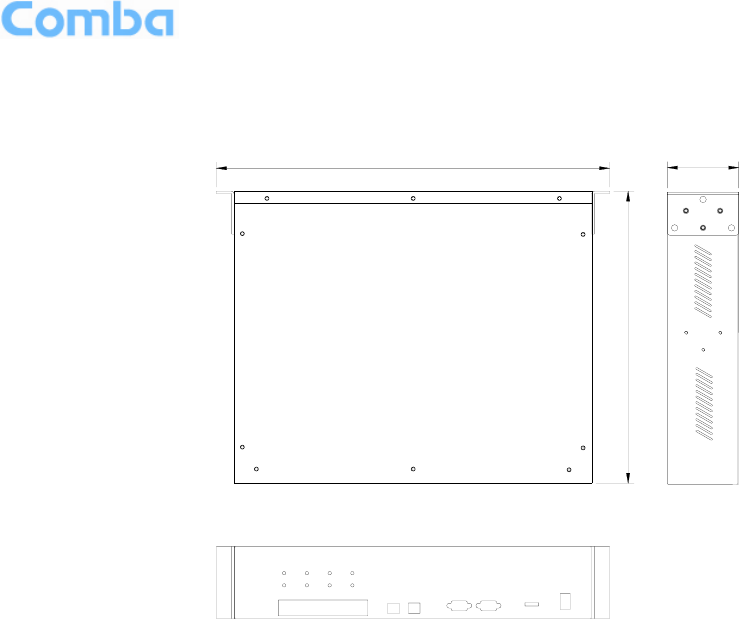
USER MANUAL FOR RH-8132
ENU STATUS : 1-0-0 Copyright - refer to title page Page 9
The figures below show the equipment enclosure layout of RH-8132 DAU and DRU.
88
482
360
RS-232 BTS_AL M
OP1 OP2 OP3 OP4
Figure 1: Front, Side and Bottom Views of DAU Enclosure
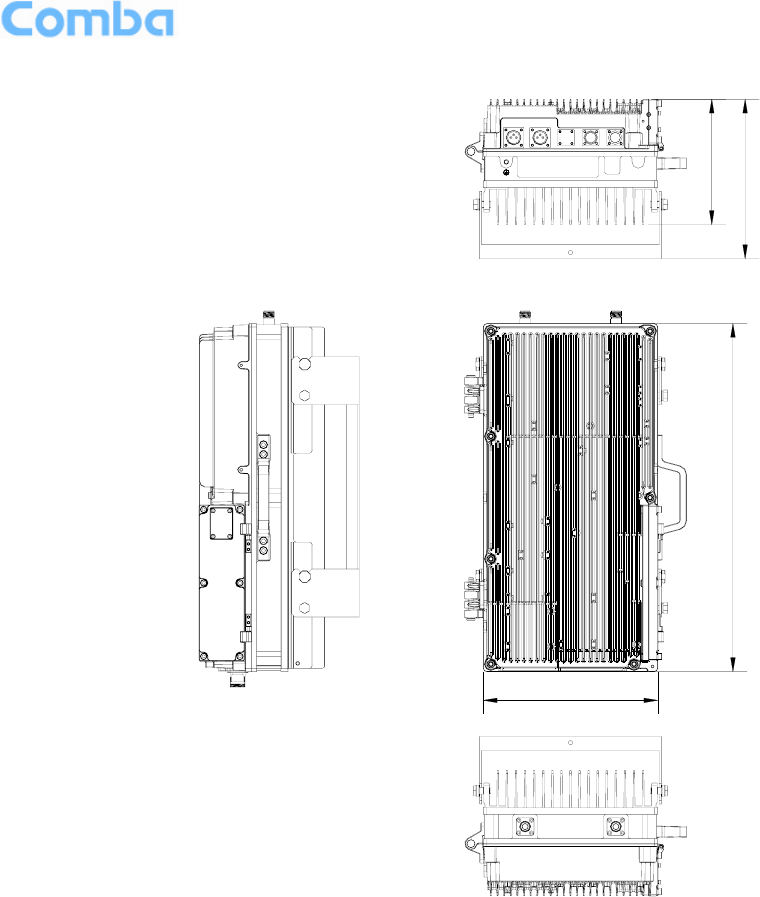
USER MANUAL FOR RH-8132
ENU STATUS : 1-0-0 Copyright - refer to title page Page 10
250
500 229
180
Figure 2: Front, Side and Bottom Views of the DRU Enclosure
End of section
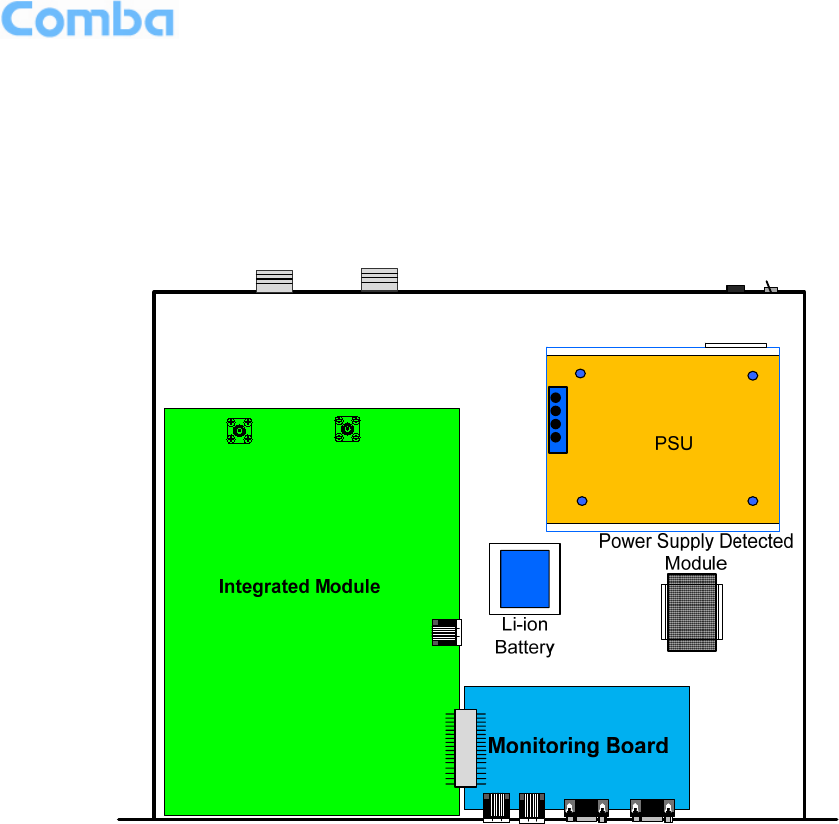
USER MANUAL FOR RH-8132
ENU STATUS : 1-0-0 Copyright - refer to title page Page 11
2 EQUIPMENT DESCRIPTION
2.1 EQUIPMENT LAYOUT
The internal layouts for the DAU are shown below:
Figure 3: Equipment Internal Layout of DAU
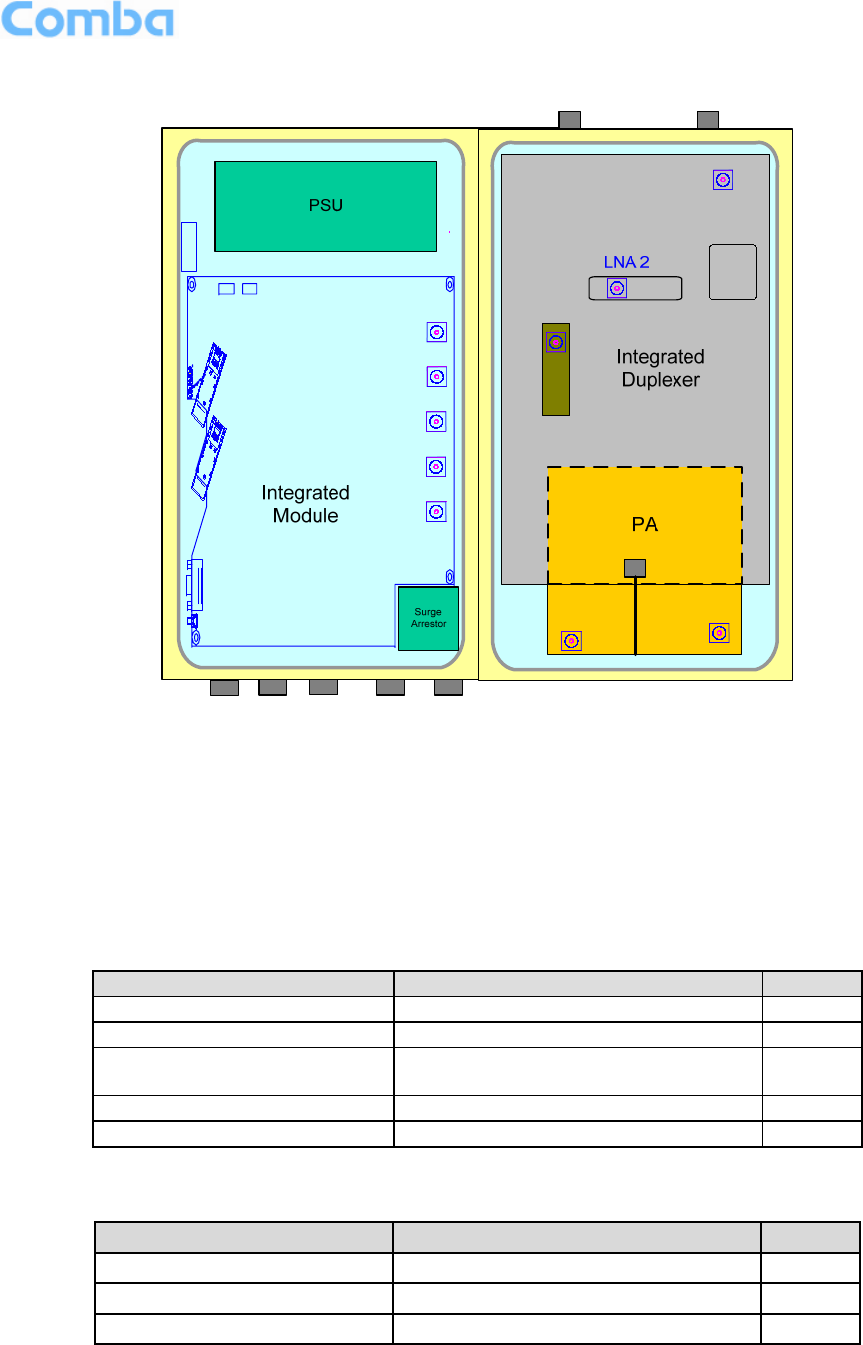
USER MANUAL FOR RH-8132
ENU STATUS : 1-0-0 Copyright - refer to title page Page 12
The internal layouts for the DRU are shown below:
Door Open
Switch
LNA 1
Figure 4: Equipment Internal Layout of DRU
2.2 KIT OF PARTS
For this system, the following are shipped:
Table 1: DAU KOP
Product Identifier Description Quantity
Omni Antenna XD-GSM-900/1800V-3 1
Wall Plug Φ8 4
Philips Pan Head Self-tapping
Screw GB/T845, ST4x25 4
Spring Washer GB/T93 4
Plain Washer GB/T95 4
Table 2: DRU KOP
Product Identifier Description Quantity
Power Supply Cable N/A 1
Fuse N/A 2
Masonry Bolt M10x110 4
End of Section

USER MANUAL FOR RH-8132
ENU STATUS : 1-0-0 Copyright - refer to title page Page 13
3 INSTALLATION
3.1 WARNINGS AND ALERTS
Laser
Laser light can cause damage to eyes. Laser light is not visible. Viewing it directly does not cause pain.
The iris of the eye will not close when viewing a bright light. Consequently, serious damage to the retina
of the eye is possible. NEVER LOOK INTO THE END OF A FIBER WHICH MAY HAVE A LASER
COUPLED TO IT.
Radio Frequency Energies
There may be situations, particularly for workplace environments near high-powered RF sources, where
recommended limits for safe exposure of human beings to RF energy could be exceeded. In such cases,
restrictive measures or actions may be necessary to ensure the safe use of RF energy.
High Voltage
The equipment has been designed and constructed to prevent, as far as reasonably, practicable danger.
Any work activity on or near equipment involving installation, operation or maintenance must be, as far as
reasonably, free from danger.
Where there is a risk of damage to electrical systems involving adverse weather, extreme temperatures,
wet, corrosive or dirty conditions, flammable or explosive atmospheres, the system must be suitably
installed to prevent danger.
Protective Earthing
Equipment provided for the purpose of protecting individuals from electrical risk must be suitable for the
purpose and properly maintained and used.
Handling Precautions
This covers a range of activities including lifting, lowering, pushing, pulling, carrying, moving, holding or
restraining an object, animal or person. It also covers activities that require the use of force or effort, such
as pulling a lever, or operating power tools.
Electrostatic Discharge (ESD)
Observe standard precautions for handling ESD-sensitive devices. Assume that all solid-state electronic
devices are ESD-sensitive. Ensure the use of a grounded wrist strap or equivalent while working with
ESD-sensitive devices. Transport, store, and handle ESD-sensitive devices in static-safe environments.

USER MANUAL FOR RH-8132
ENU STATUS : 1-0-0 Copyright - refer to title page Page 14
3.2 SITE PLANNING CONSIDERATIONS
Site Considerations
The DAU can be located indoors to facilitate coupling of BTS signals and power supply connections. The
recommended input range of BTS signal is -15~5 dBm. Hence, an appropriate coupler must be used
according to input power of the repeater.
The DRU is designed to be waterproof, rainproof, and with snow protection. Temporary protection should
be taken when the equipment enclosure is opened for installation or maintenance in an outdoor
environment. The equipment must not be opened for installation or maintenance in bad weather (e.g.
gale, storm rainfall, extreme temperatures and high humidity)
The site considerations for DRUs are listed below:
• The distance between the service antenna of DRU and coverage area should satisfy line of sight
requirements for maximum coverage area.
• The maximum fiber length is 20km, with a maximum optical path loss of 10dB.
• The system delay of the optical system must be taken into consideration when there are neighboring
BTS sites overlapping in coverage.
Installation Location
Mounting surface shall be capable of supporting the weight of the equipment.
In order to avoid electromagnetic interference, a proper Mounting location must be selected to minimize
interference from electromagnetic sources such as large electrical equipment.
Environmental
Humidity has an adverse effect on the reliability of the equipment. It is recommended to install the
equipment in locations having stable temperature and unrestricted air-flow.
The installation location for the product should be well ventilated. The equipment has been designed to
operate at the temperature range and humidity level as stated in the product specifications in the
datasheet.
Direct sun light exposure to the equipment should be avoided. Provide additional shelter if necessary.
Powering
The power supply unit (PSU) provides power to all modules within the equipment. Depending on the
product variant, it is recommended that the PSU operates on a dedicated circuit breaker or fused circuit.
Grounding Requirement
Verify that the equipment has been well grounded. This includes antennas and all cables connected to
the system. Ensure lightning protection for the antennas is properly grounded.
Cable Routing
Depending on equipment configuration, a variety of types of cables are required. Where applicable,
ensure cables are properly routed and secured so that they are not damaged.
Manual Handling
During transportation and installation, take necessary handling precautions to avoid potential physical
injury to the installation personnel and the equipment.

USER MANUAL FOR RH-8132
ENU STATUS : 1-0-0 Copyright - refer to title page Page 15
3.2.1 REPEATER INSTALLATION CHECKLIST
z Working space available for installation and maintenance for each mounting arrangement. Ensure
unrestricted airflow.
z Ensure earthing point is within reach of the ground wire.
z Ensure a power source is within reach of the power cord and the power source has sufficient
capacity.
z Where appropriate, ensure unused RF connectors are terminated.
z Where appropriate, ensure unused optical fibre connectors are protected.
z Do not locate the equipment near large transformers or motors that may cause electromagnetic
interference.
z Reduce signal loss in feeder cable by minimizing the length and number of RF connections.
z Ensure the equipment will be operated within the stated environment (refer to datasheet).
z Where needed, couple BTS RF signal with a coupler to prevent damaging the equipment.
z Where appropriate, confirm available of suitably terminated grade of RF and optical fiber. (optical
fiber ≤ 20km from DAU to DRU)
z Observe handling of all cables to prevent damage.

USER MANUAL FOR RH-8132
ENU STATUS : 1-0-0 Copyright - refer to title page Page 16
3.3 INSTALLATION PROCEDURES
3.3.1 GOODS INWARDS INSPECTION
1. Verify the number of packages received against the packing list.
2. Check all packages for external damage; report any external damage to the shipping courier. If there
is damage, a shipping agent should be present before unpacking and inspecting the contents
because damage caused during transit is the responsibility of the agent.
3. Open and check each package against the packing list. If any items are missing, please contact
Comba.
4. Do not remove items from antistatic packing until ready for installation. If damage is discovered at the
time of installation, contact the shipping agent.
3.3.2 TOOLS
See Appendix A for a full list of the recommended tools required for installation and maintenance.
3.3.3 PREPARATION
Optical Fiber:
• Optical fibers require proper handling. Do not stretch, puncture, or crush the fiber cable with staples,
heavy equipment, doors, etc.
• Always maintain the minimum bending radius specified by the cable manufacturer. The minimum
bend radius is usually 10 times the cable's outer diameter. In the case of a single optical fiber that is
not enclosed by the jacket, the minimum bending radius is 3cm.
3.3.4 DAU MOUNTING RACK
The mounting rack is used for mounting the equipment to either a wall or on a pole. Shown below is the
diagram of the mounting rack. The round holes are used for masonry bolts, and square holes for carriage
bolts.
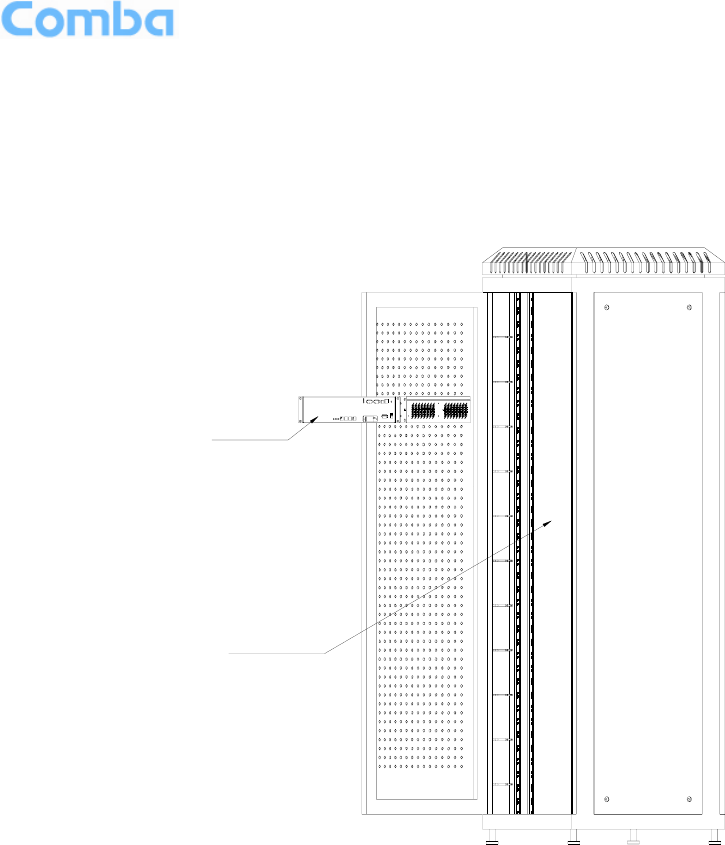
USER MANUAL FOR RH-8132
ENU STATUS : 1-0-0 Copyright - refer to title page Page 17
3.3.5 CABINET MOUNTING OF DAU
If a 2-post open-rack is to be used for installation of the DAU, the mid-mounting brackets are to be used.
For rack or cabinet mounting, the mid-Mounting brackets are to be removed from the 4U shelf. Cage nut
and screws are not supplied. Unless otherwise recommended by rack manufacturer, M6 cage nut / bolt
are to be used.
Enclosure
19"Cabinet
Figure 5: Cabinet Mounting of DAU
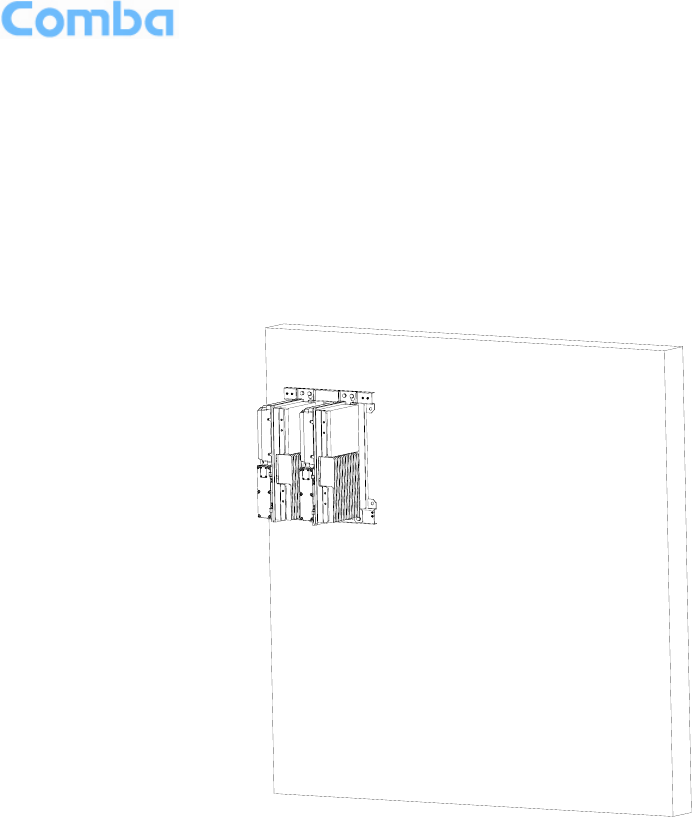
USER MANUAL FOR RH-8132
ENU STATUS : 1-0-0 Copyright - refer to title page Page 18
3.3.6 DRU WALL MOUNTING
z Drill holes on the wall by using the position of the four round holes on the Mounting rack as a guide.
z Insert the masonry bolts M10x110 through the round holes and tighten them to take the weight of
the entire DRU.
z Hook the enclosure up onto the mounting rack and align the hole positions to that of the mounting
rack, then installed the hex socked bolt (M8 x 12) to complete the installation.
Figure 6: Wall Mounting Overview
3.3.7 DRIP-LOOP
Comba recommends that every horizontal cable entry to the equipment forms a 'U' before it’s entry to the
equipment. Any accumulated water on the cable will drip down at the bottom of the loop and will not
accumulate at the equipment connectors.
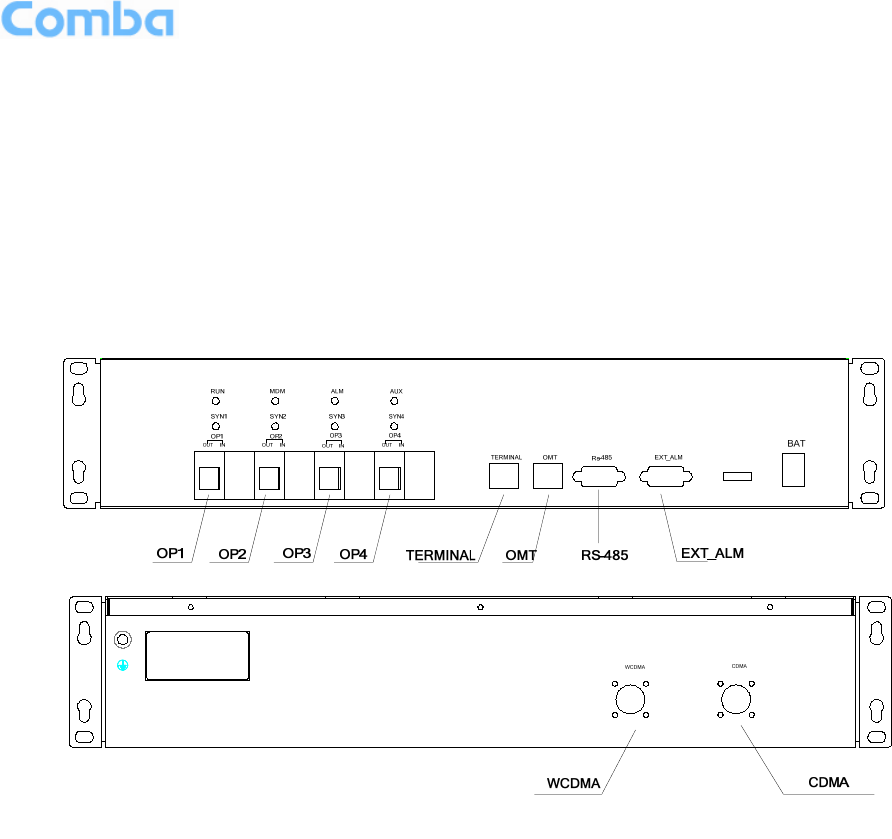
USER MANUAL FOR RH-8132
ENU STATUS : 1-0-0 Copyright - refer to title page Page 19
3.4 EQUIPMENT CONNECTORS
The DAU is connected via the connectors located on the front and back panel. The DRU is designed for
all cables entries from the bottom of the enclosure.
3.4.1 DAU CONNECTORS
3.4.1.1 DAU Connectors
Figure 7: DAU Connectors
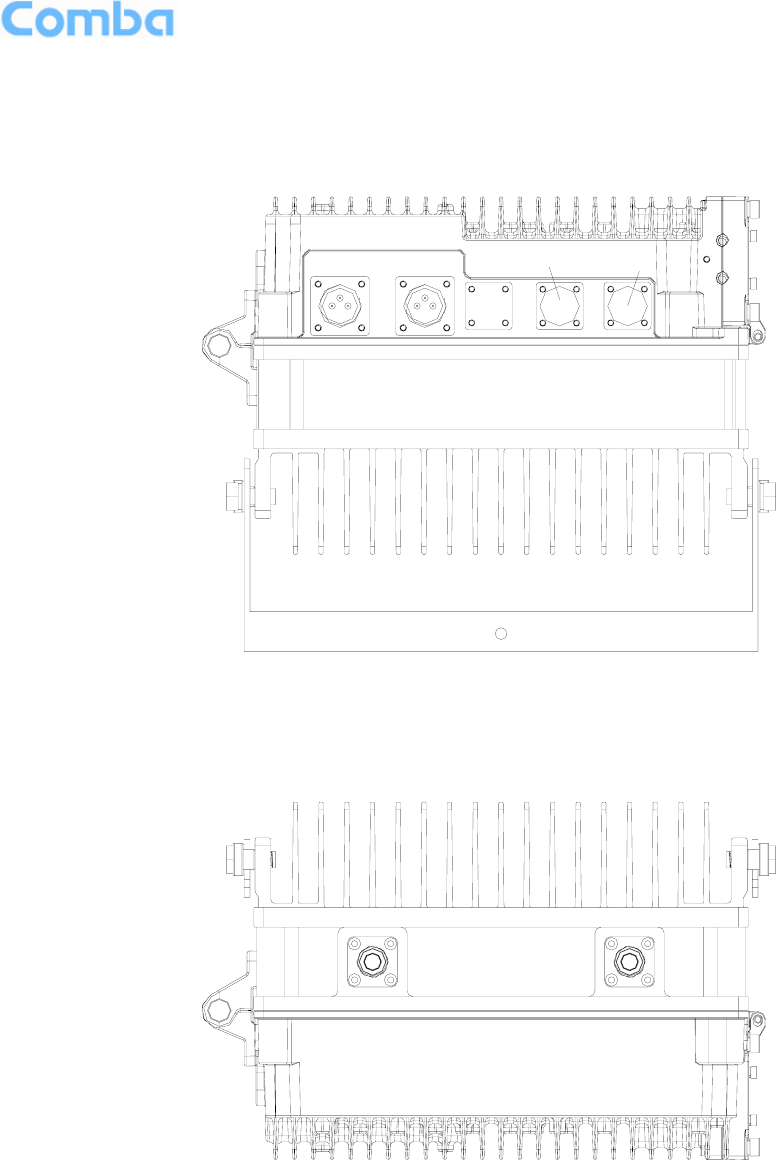
USER MANUAL FOR RH-8132
ENU STATUS : 1-0-0 Copyright - refer to title page Page 20
3.4.2 DRU CONNECTORS
Connectors on the DRU are identified below:
POWER BAT DISPLACE_ALM EXT_ALM
RX TX
Figure 8: RH-8132 DRU Bottom Panel

USER MANUAL FOR RH-8132
ENU STATUS : 1-0-0 Copyright - refer to title page Page 21
3.5 EQUIPMENT CONNECTION
3.5.1 GROUNDING CONNECTION
Ground Connection
To ensure safe operation of the product, a ground (earth) connection is required. For single phase AC
power source, the product must be grounded by connecting the “earth wire” of the power cord to the
ground terminal of the AC supply. For operating this product with DC power system (such as rectifiers),
the product should not be connected to power systems that switch open the return lead because the
return lead could function as the ground (earth) connection for the equipment.
Protective Ground Connection
The enclosure must be grounded securely by connecting a copper wire (CSA 16mm2) to the grounding
terminal on the equipment/rack, and the other end to a protective ground (i.e., building earth point). An
internationally acceptable colour code of the ground connection wire is green/yellow.
Such a ground connection implements the “Protective Ground Connection”, and must be connected to
the equipment at the designated ground point, and preferable using crimp connectors. In general, do not
connect the supply before establishing an adequate ground (earth) connection.
1. DAU Grounding Connection
Connect the grounding terminal located on the back panel of DAU to a protective ground (i.e., building
earth point).
2. DRU Grounding Connection
The equipment must be grounded securely. Connect a copper wire to the grounding terminal located on
the cooling fin, and connect the other end to a protective ground (i.e., building earth point). An
internationally acceptable colouring code of the ground connection wire is green/yellow.
3.5.2 LI-ION BATTERY CONNECTION
Li-ion battery is provided with this system to ensure power is supplied to the system monitoring unit and
MCU and to ensure the alarm message could be sent to OMC effectively in case of mains power failure.
Caution: Be careful of the risk of explosion if battery is replaced by an incorrect type. Dispose of used
batteries according to the instructions.
DAU Li-ion Battery Connection
The Li-ion battery is located within the PSU SIU and is disconnected prior to shipment. Before equipment
power up, user needs to withdraw the PSU SIU from the DAU shelf, locate and connect the in-line
connector of the battery pack and then reinsert the PSU SIU.
DRU Li-ion Battery Connection
With the equipment lying flat, remove the bolts with an Allen Key, unlock and open the enclosure door.
Locate the battery pack, the in-line connector of the battery pack is “disconnected” from the PSU during
shipment. Connect the in-line connector, turn on the battery switch located on the PSU, close the
enclosure door, insert and tighten bolts to complete this procedure.

USER MANUAL FOR RH-8132
ENU STATUS : 1-0-0 Copyright - refer to title page Page 22
3.5.3 OPTICAL CONNECTION
The DAU is connected to DRU via optical fiber (length < 20km). Connect the LC/UPC connector to one
port between OP1~OP2, and FC/UPC to optical adaptor.
On the DRU, there are two optical ports. NOTICE: OP1 shall be connected with the upper level of
DAU or equipment and OP2 shall be connected with sub level of DAU or equipment.
WLAN port is used for connecting with baseband transmit.
3.5.4 ETHERNET CONNECTION
Connect the local RJ45 Ethernet connector to the DAU TERMINAL when DRU adopts remote monitoring
via Ethernet.
3.5.5 CONNECTION TO PC
Connect DAU to PC
Connect the RS-232 port located on the MCU SIU module to the serial port of PC with the
RS-232 cable supplied to achieve local monitoring.
Connect DRU to PC
Connect the RS-232 port located on the bottom of the DRU to the serial port of PC with the RS-232 cable
supplied to achieve local monitoring.
3.5.6 EXTERNAL ALARM CONNECTION
Four external alarms INPUT to DRU are realized on the “EXT_ALM” port, this is a 7-pin CPC connector.
The following figure and table shows the pin allocation and definition. Pin numbering are shown looking-
into the connector on the enclosure.
76
35
4
12
Figure 9: Pins Allocation for “EXT_ALM” Port
Table 3: Pin Definition of “EXT_ALM” Port
Pin number 1 2 3 4 5 6 7
Alarm
definition
EXT.
Alarm 1
EXT.
Alarm 2
Reserve
d GND Reserved Reserved Reserved
End of section

USER MANUAL FOR RH-8132
ENU STATUS : 1-0-0 Copyright - refer to title page Page 23
4 COMMISSIONING
4.1 PRE-COMMISSIONING TASKS
After equipment installation, perform the following steps before equipment powering and commissioning,
check that the expected voltage, current, and power levels do not violate any ratings. Double check all
connections including ground before applying power. Do not manipulate circuits or make changes when
power is applied:
• Visually inspect the power connection within the equipment. Ensure that the power cable is correctly
and securely connected, including grounding wire, RF cable and optical cable.
• Check grounding connection and verify that the ground resistance is less than 5Ω.
• Connect the equipment to the PC installed with OMT software.
• With the DAU installed, apply power to the DAU by switching on the “Power” switch.
• With the DAU switched on, DRU installed and all cablings connected, apply power to the DRU by
switching on the PSU switch on the integrated PSU.
• Monitor the initialization of DAU and DRU wait until equipment initialization has completed.
• The online commissioning can be commenced with following the commissioning steps.
4.2 COMMISSIONING PROCEDURES
Since end-to-end connection is available for RH-8132 OMT software, users can configure the parameters
at DAU, and then offset the parameters of DAU at DRU according to desired coverage level and
interference to other BTS signals. Perform the following procedures for system commissioning.
• Locally connect to DRU(s) and set its site ID.
• Locally connect to DAU and set its site ID and network parameters. Then register the site ID of DRU
at DAU.
• Check the working status of DAU and DRU. If damage occurs, proceed with RMA process.
• At DRU, adjust downlink gain so that the output power can achieve the design requirement.
• At DAU, configure the uplink gain of DAU to make the UL output noise level to be lower than the BTS
noise threshold. Refer to the table below for the comparison between UL gain and UL output noise
level of DAU.
• Configure the UL gain of both DAU and DRU to ensure high quality communication link within the
desired area.
• Confirm no interference to BTS to complete commissioning.
End of section

USER MANUAL FOR RH-8132
ENU STATUS : 1-0-0 Copyright - refer to title page Page 24
5 MAINTENANCE
The RH-8132 repeater is designed for trouble-free operation and generally does not need maintenance.
Maintenance activities should only be carried out by trained personnel.
The equipment operation status can be observed remotely through OMT/OMC.
Periodic inspection of the repeater equipment(s) is recommended. The recommended tasks include:
• Measurement of the return loss of the feeder system.
• Ensure the stable connection of cables, power cords and facilities located indoor.
• Inspect and record operation status and parameters, such as receive signal level, output noise level,
DL output power of the repeater, from OMC or OMT.
• Check the PSU voltage of DAU.
• Verify that the actual coverage effects have not degraded.
• Check the working status of optical TX/RX power.
• Check the controlling and monitoring function.
• Verify lightning and grounding protection is in good condition.
• Ensure the labels are clear and legible.
End of section

USER MANUAL FOR RH-8132
ENU STATUS : 1-0-0 Copyright - refer to title page Page 25
6 APPENDICES
6.1 APPENDIX A: TOOLS FOR INSTALLATION AND MAINTENANCE
The following are the recommended list of tools new installation and routine maintenance:
• Slotted screwdriver
• Philips screwdriver
• Ring spanner (Assorted size: 12~20mm)
• Electrically operated drill and masonry drill bits ∅10mm
• Anti-static wrist strap
• Allen key (M5.5)
• Side cutter
• Frequency counter (e.g. FLUKE PM6685R)
• RF Power Meter (e.g. Bird 5000)
• T-shaped Pentagon Key Wrench
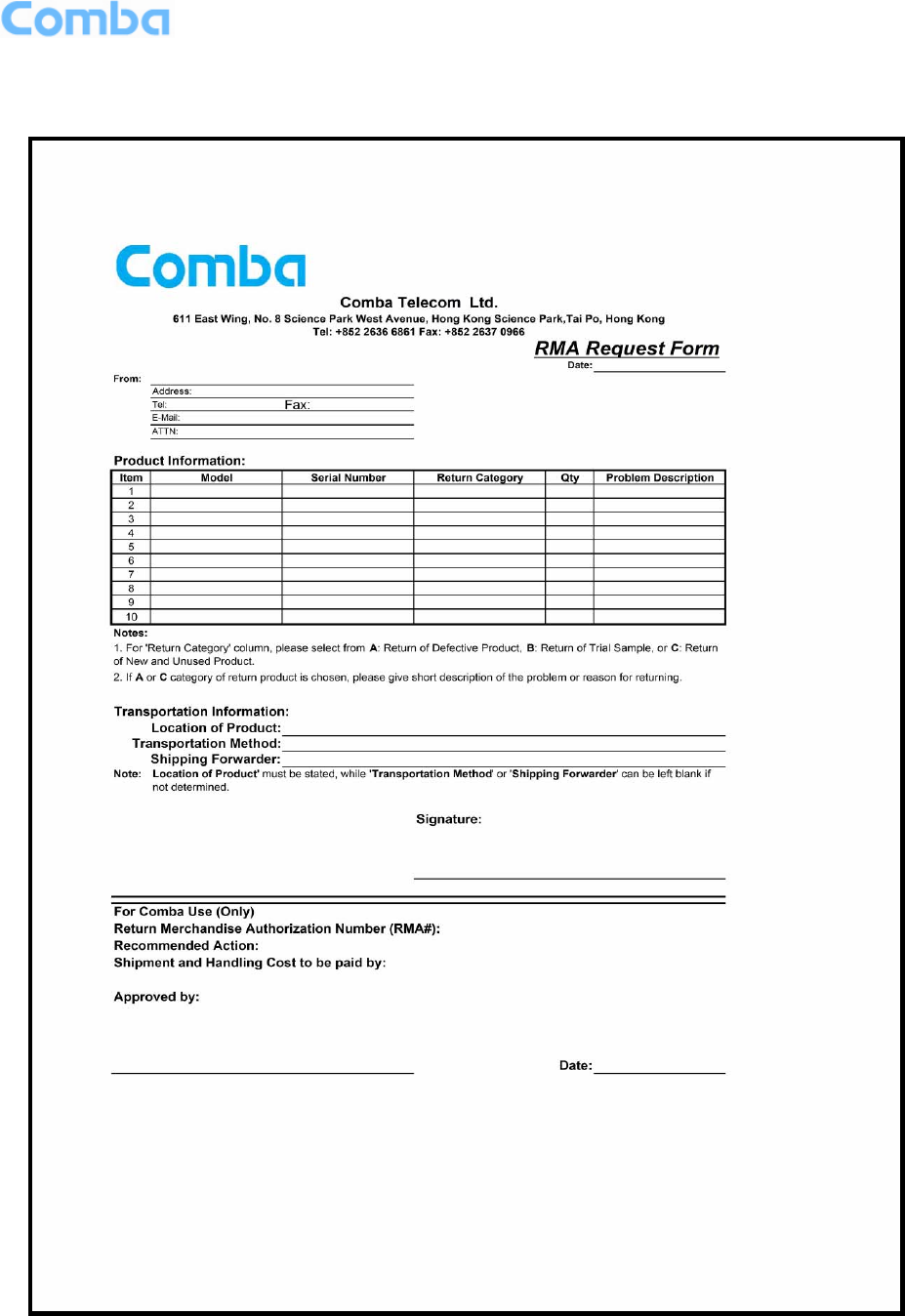
USER MANUAL FOR RH-8132
ENU STATUS : 1-0-0 Copyright - refer to title page Page 26
6.2 APPENDIX B: RMA (RETURN MATERIAL AUTHORIZATION) FORM
End of section
End of Document
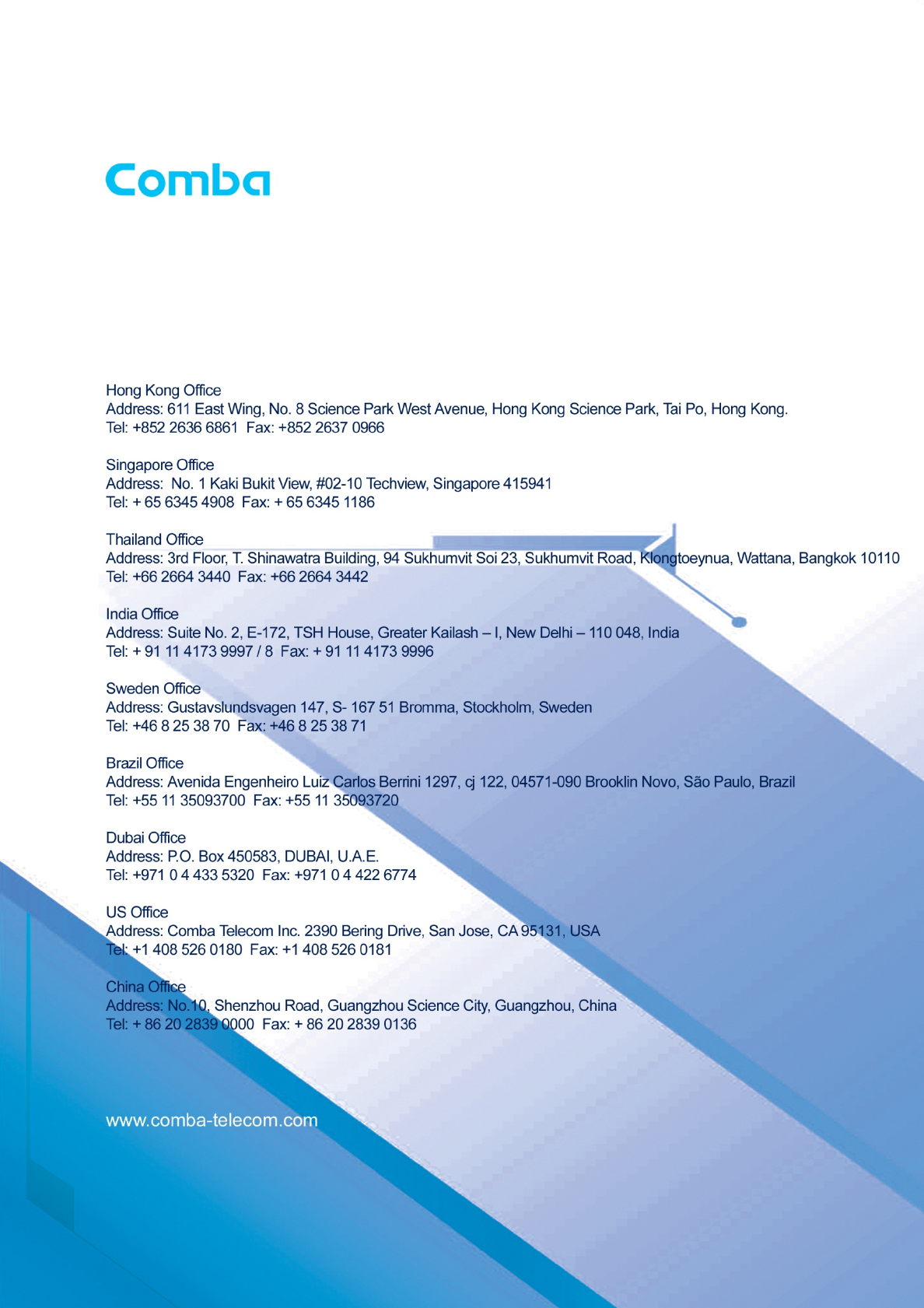
USER MANUAL FOR RH-8132
ENU STATUS : 1-0-0 Copyright - refer to title page Page 27